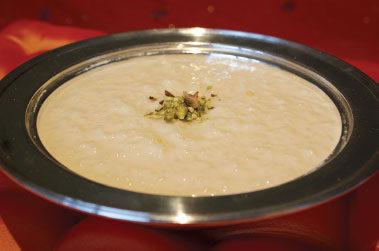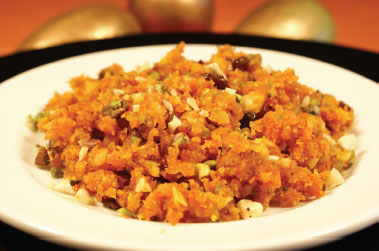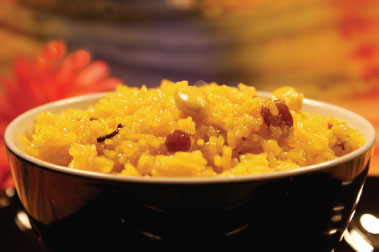
This rice “pudding” is made with basmati rice, the grains of which have more aroma and a firmer texture than pudding rice, even after long, slow cooking. I like to make this dessert with 1 percent or skim milk because I find the long, slow cooking makes the dish creamy enough, but you can use full-fat milk if you prefer, for an even creamier dessert.
Kheer is delicious served warm, or cold straight from the fridge.

▪ Wash the rice several times in cold water and place in a large, heavy-based saucepan with the milk.
▪ Slowly bring to a boil. Turn down the heat to very low, partly cover the pan, and simmer for about 1½ hours, stirring now and then. Add more milk if the mixture is too thick.
▪ Stir in the sugar, and simmer for another 20 minutes.
Stir through a couple of tablespoons of chopped almonds and pistachios, or a handful of sultana raisins about halfway through cooking.
This is a really easy recipe that is deliciously creamy considering there is very little cream in it. In fact the health and weight conscious can omit the cream altogether and replace it with evaporated milk, with very little loss of texture or flavor.
If you have an ice-cream maker, you can prepare this dessert while you are eating dinner. Otherwise, it will take about 4–5 hours in the freezer.
▪ Whisk all the ingredients in a bowl. Place in your ice-cream maker and prepare the ice cream according to the manufacturer’s instructions.
▪ If you don’t have an ice-cream maker, place the mixture in the freezer. Remove from the freezer after 30 minutes and beat with a whisk or a fork until smooth. Repeat twice more and freeze until hard.
A lovely, no-cook, cool treat after a spicy meal, this is a delicious and creative dessert with ripe, sweet mangoes. Pureed fruits like strawberries, raspberries or apricots could be used instead.

▪ Prepare six ramekins (that can hold 6 fl oz or 180 mL each) by tying a strip of parchment paper around the rim of each ramekin. The parchment paper should be positioned about 1 inch (2.5 cm) below the rim and should extend about 1 inch (2 cm) above the rim.
▪ Add the gelatin to the water in a small pan and soak for 10 minutes. Heat gently until dissolved. Add the finely granulated sugar and stir until dissolved. Set aside to cool.
▪ Beat the cream until soft peaks form. Beat the egg whites until stiff.
▪ Place the custard in a large bowl and stir in the mango pulp and lime juice, followed by the gelatin, cream and egg whites. Mix until combined.
▪ Pour the mixture into the ramekins so it comes about halfway up the parchment-paper strip. Refrigerate until set.
▪ Carefully remove the paper and serve with extra fruit if desired.
The combination of grated carrots, nuts, cardamoms, sugar and pure ghee produces a dessert with a lovely texture and an absolutely delicious taste. Don’t compromise on the ghee though; nothing else will do for this dessert.
Gajrella will keep in the fridge for several days, but halve the quantity of ingredients if you don’t want to make so much.

▪ Place the carrots in a large, heavy-based saucepan with 4 tablespoons of water and cook, stirring, on high heat for about 3 minutes. Turn down the heat, cover and cook for another 5 minutes, stirring once or twice.
▪ Add the ghee, turn up the heat again and stir-fry the carrots for another 5 minutes.
▪ Lower the heat and stir in the cardamom and nuts, saving about 2 tablespoons. Continue to cook over low-medium heat, stirring frequently, until the carrots have turned a deep orange and the ghee has started to separate from the mixture. This will take about 20 minutes.
▪ Stir in the raisins and sugar and stir-fry on low heat for another 5 minutes. Add the condensed milk, turn up the heat a little and stir-fry the mixture for about 3 minutes.
▪ Stir in the ground almonds and mix over low heat until well combined.
▪ Serve warm, garnished with the remaining nuts, with thick cream or ice cream. Or press into a jelly roll pan, refrigerate until firm and cut into squares. Serve with tea or coffee.
Note: This recipe works best with organic carrots as they contain less water than their nonorganic counterparts.
A dish that celebrates the versatility of rice beautifully, this sweet, perfumed pilau is simple yet quite exquisite.
The typical beautiful deep-yellow color of this dish is unfortunately a result of artificial food coloring, but you can leave it out and have a dish that is paler in color but still tastes wonderful.

▪ Combine the saffron and warm water, and set aside. Wash the rice a few times and leave to drain for several minutes.
▪ Meanwhile, put the hot water and sugar in a large saucepan, and place over low heat, stirring to dissolve the sugar. Once the sugar has dissolved, turn up the heat and bring to a boil. Turn off the heat and stir in the coloring if you are using it.
▪ Heat the ghee in a large, heavy-based saucepan and add the rice. Stir until the grains of rice are well coated with the ghee.
▪ Add the cardamoms, cloves, almonds and raisins. Stir-fry for 2 minutes.
▪ Carefully (as it will spit) pour in the sugar syrup. Turn the heat down to very low, stir in the saffron water, and simmer gently for about 30 minutes, stirring now and then to ensure the rice cooks evenly.
▪ Turn off the heat and let the rice stand, covered for 10 minutes. Fluff up with a fork and serve hot or cold.
Often referred to as Indian ice cream, kulfi is still one of the most popular desserts on the Indian restaurant menu. This quick recipe cuts out a lot of time-consuming effort but still produces a wonderful result.
▪ Heat half the milk in a small pan, add the sugar and stir to dissolve over low heat. Cool.
▪ Place all the remaining ingredients except the nuts in a large bowl, add the sweetened milk and whisk until well combined.
▪ Stir in the nuts and divide the mixture among 6 kulfi molds. Freeze until completely hardened.
▪ Dip the molds in hot water to loosen the frozen kulfi and serve sprinkled with more nuts if desired.
TIP
If you don’t have kulfi molds, freeze the mixture in shallow pans or trays, remove from the freezer about 15 minutes before serving, and cut into squares.